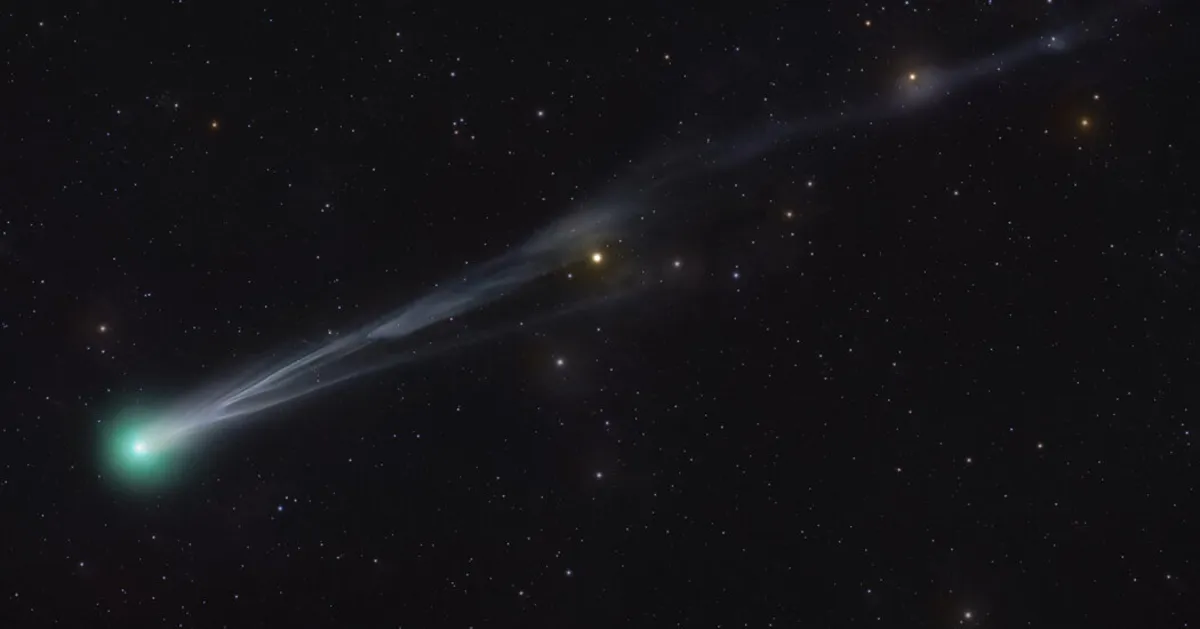
If you're a fan of celestial wonders, this month offers an incredible opportunity for skywatchers. October 2023 is shaping up to be a remarkable season for observing comets, as a variety of these cosmic travelers grace our skies, leaving trails of gas and dust in their wake. Northern Hemisphere stargazers will have the chance to witness not one, but two extraordinary comets this fall: C/2025 A6 (Lemmon) and C/2025 R2 (SWAN).
Both comets have ventured from the far reaches of our solar system, where the sun appears merely as a pinprick of light set against the vastness of space. Comet A6 (Lemmon) was first detected in January by the Mount Lemmon Survey, a project dedicated to cataloging near-Earth objects from a mountaintop observatory in Arizona. On the other hand, R2 (SWAN) appeared in early September, discovered by amateur astronomer Vladimir Bezugly in Ukraine. This unexpected visitor was identified in publicly available images from the Solar Wind Anisotropies (SWAN) instrument, part of the Solar and Heliospheric Observatory (SOHO) spacecraft, stationed nearly a million miles from Earth.
Quanzhi Ye, an astronomer at the University of Maryland, noted that R2 (SWAN) caught the scientific community by surprise due to its trajectory; it approached from the direction of the sun, rendering it invisible to telescopes until now.
Comets are ancient remnants of ice and rock, leftovers from the formation of the solar system. As they draw near to the sun, the heat causes some of the ice to sublimate into gas, which escapes into space, pulling along dust and forming a characteristic shimmering tail.
After a captivating display in the Southern Hemisphere, R2 (SWAN) is now becoming visible in the northern evening sky this week and will remain so until the end of October. To catch a glimpse of this intriguing comet, astronomers recommend finding a dark location with minimal light pollution and an unobstructed view to the southwest. The comet is expected to be too faint for the naked eye, so be prepared to use binoculars or a small telescope. About 45 minutes to an hour after sunset, scan low along the horizon to spot the comet, which will appear as a “fuzzy ball,” according to Yoonyoung Kim, a comet researcher at UCLA.
Conditions for observing R2 (SWAN) are expected to improve as it approaches Earth, with its closest encounter occurring on October 20. Each night, the comet will rise higher in the sky, moving away from the sun's lingering glow.
Comets are notoriously unpredictable, often surprising astronomers with sudden increases in brightness. R2 (SWAN) has already shown such tendencies, leading experts to speculate that it could undergo another outburst, potentially becoming visible without binoculars. However, there's also a chance that the comet may disintegrate entirely, leaving astronomers eagerly wondering about its fate.
Currently, A6 (Lemmon) can be seen in the northern morning sky. To observe this comet, you’ll need binoculars or a small telescope, as well as the determination to wake up before dawn. Look for a fuzzy object in the northeast sky, just below the Big Dipper, several hours before sunrise. Midway through October, A6 (Lemmon) is expected to shift to the evening sky in the west. If forecasts prove accurate, the comet may brighten in late October and early November, potentially becoming visible to the naked eye under optimal conditions.
Stargazers may have the unique opportunity to see both comets around Halloween. According to David Dickinson, an amateur astronomer and author of “The Backyard Astronomer’s Field Guide,” A6 (Lemmon) will be closer to the horizon and might get obscured by twilight. Meanwhile, R2 (SWAN) will linger in the sky for hours post-sunset, making it the more viable option for those seeking an evening cosmic spectacle.
The two comets likely hail from the Oort Cloud, a vast, spherical region of icy objects surrounding our solar system. As explained by Carrie Holt, an astronomer at Las Cumbres Observatory, these comets may have been nudged inward to the inner solar system long ago, possibly influenced by a passing star or the gravitational forces of the Milky Way. Current estimates suggest that A6 (Lemmon) orbits the sun approximately every 1,359 years, while R2 (SWAN) completes its journey every 619 years.
In contrast, other comets can be found closer to the sun, within the Kuiper Belt beyond Neptune, typically taking less than 200 years to orbit. Some comets even originate from interstellar space, such as 3I/ATLAS, which is currently passing through the inner solar system but will be out of view this month.
For comet researchers, encounters with Oort Cloud comets provide invaluable insights into cosmic history. These comets are remarkably well-preserved, retaining materials that date back over four billion years, offering a glimpse into the early solar system. If A6 (Lemmon) and R2 (SWAN) avoid disintegration, both will return to the cold, distant regions of space, forever changed by their close encounter with the sun. As Quanzhi Ye aptly puts it, “it’s actually pretty boring because it’s cold, and there’s not much going on” out there. This flyby of Earth represents a thrilling event for both comets and observers alike, so don't miss the chance to witness these spectacular cosmic phenomena!